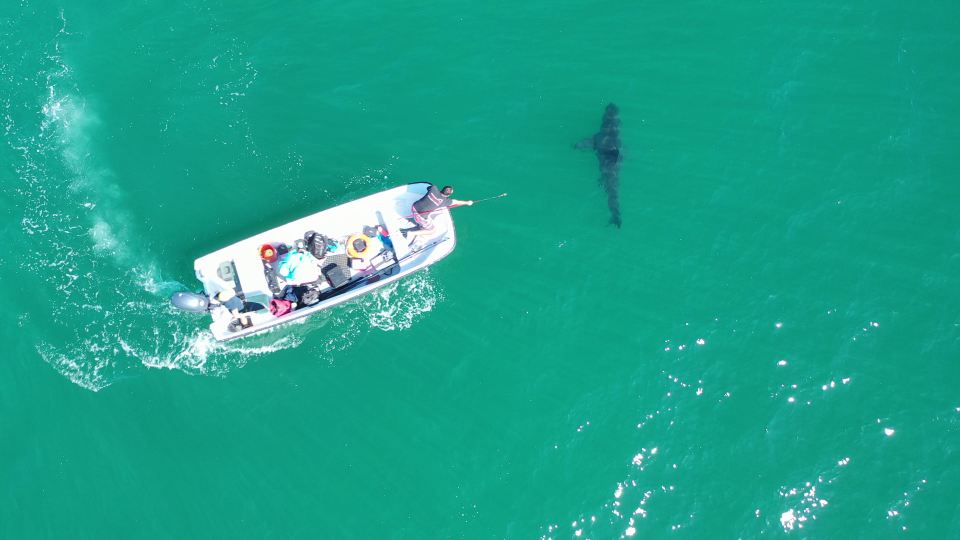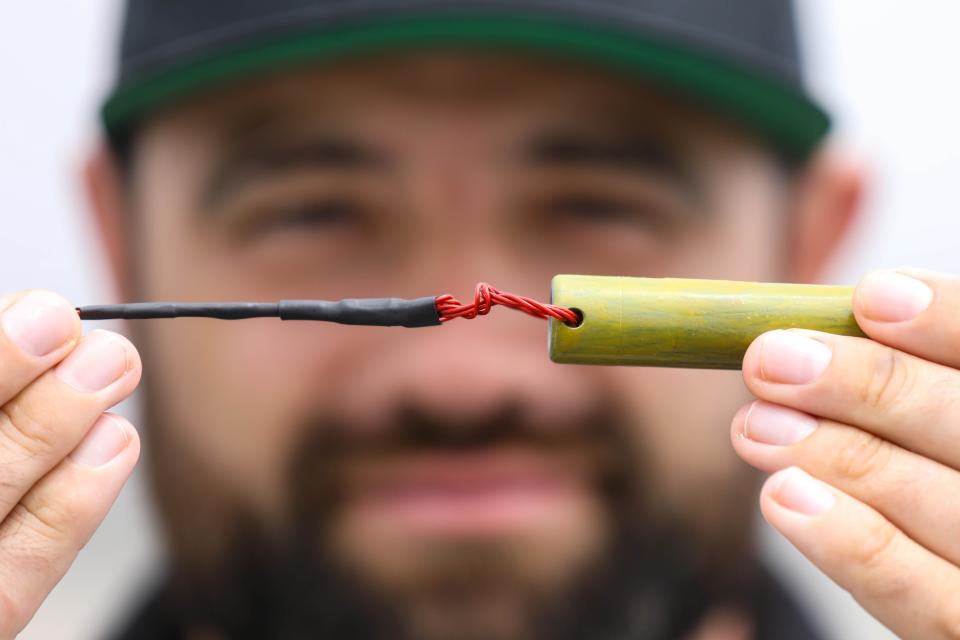California's great white shark population is growing, but risk of attack isn't. Here's why.
If you have ever wanted to swim with sharks, chances are you already have. Especially, if you frequent any southern California beaches.
SoCal beaches have become a hotbed for juvenile great white sharks in recent years. Since beaches have warmer water, there are plenty of stingrays, fish and squid to feed on and sharks remain safe from other predators, according to California State University at Long Beach’s Shark Lab.
Patrick Rex, a lab technician at CSULB Shark Lab set off with a drone to study how juvenile great white sharks behave while in close proximity to humans.
This study is the first of its kind that observed both humans and sharks at the same time, Rex shared with USA Today.
A big reason why Rex was able to conduct the two-year study fairly easily was because he had the right shark population and a cheaper way to observe them. He was also able to observe the sharks without influencing their behavior, which is a common issue scientists face when studying them.
“And of course, [an attempt at answering] the golden question in shark sciences … which is why do sharks bite people?,” Rex shared.
What makes this question difficult to answer is how rare shark bites are in the first place and how you rarely, if ever, get the whole scenario, Rex said.

“We don’t know what the shark was doing before. We may have a rough estimate of what the person was doing, either swimming or surfing but we rarely get a clear picture of what happened during or after because the victim is often traumatized,” Rex shared.
The shark could have been acting aggressive, trained to defend a fresh kill, or trying to get the person out of its way which are all potential reasons for why a shark could bite someone, Rex said.
As the southern California coast continues to contend with a booming human and shark population, here is what the CSULB Shark Lab has to say about how often they are both in the same place at the same time.
ICYMI: How (and where) to watch the 35th Annual Shark Week
How scientists are studying sharks
Conservation efforts and recovery of food sources in California over the past 30 years has also played a role in growing the Great White Shark population, according to CSULB Shark Lab.
With greater access to aerial video equipment than ever before, it should come as no surprise that people are seeing more sharks because there are more sharks to see, said Rex.
“That’s why some people are like, ‘Oh my gosh, sharks are everywhere.’ They’re not everywhere, they are in select key locations. And there’s a lot of them in those key locations,” Rex shared.
Key shark locations include Santa Monica Bay, Huntington Beach, and San Clemente, all popular surf locations, according to CSULB Shark Lab.
The CSULB Shark Lab has performed over 1,600 aerial drone survey flights at 34 different beaches in southern California since 2019 to observe human-shark interactions.
The footage has also allowed scientists to determine how many sharks are in the area, where they are spending their time, and how close to shore they come.
Surfers, swimmers, paddleboarders, body boarders are studied in conjunction to determine which group is more likely to encounter and interact with juvenile white sharks, according to CSULB Shark Lab.
Surfers are more likely to encounter juvenile white sharks because more people surf year-round.

The stark difference between this technique and those employed traditionally via the use of an extensive acoustic receiver to track tagged sharks is that the latter can’t track human behavior or provide any specific positional data.
Scientists use a modified pole spear with a modified tip that is about five inches to tag the shark, almost like a piercing as it swims, Rex shared. Its purpose is to track the shark and get a better idea of how it's using the environment over long periods of time. The battery life of the tag is about 10 years, but scientists only really get a couple years of data from the tag.
Most of the time, the juvenile sharks can be found within 250 yards of the shoreline. Since the sharks are fully independent from the moment they are born, the newborns tend to move towards the shoreline for protection and warmth.
They tend to migrate between their favorite nursery habitats, which tend to be farther offshore. When conditions are calmer, they tend to move closer to shore.
Sharks can remain at aggregation sites for several months on end, highest peak being in the summer.
Human and shark encounters are more likely to occur as sharks migrate between sites. Interactions were rarely observed outside of these areas, according to CSULB Shark Lab.

Climate change could potentially impact number of human-shark encounters
What CSULB Shark Lab scientists have seen in the last couple years is groups of sharks staying at one particular beach for years at a time, but they are not completely sure why groups form along certain beaches or why the groups split up and move locations.
One graduate student found that if the water gets colder for a long enough period of time, they are more likely to leave the area. This information can help lifeguards to monitor the area better.
“Juvenile white sharks are very temperature sensitive. They don't like things that are too cold, and they don't like things that are too warm. So, they're kind of like the Goldilocks,” Rex said.
Generally, they stay in southern California for the summertime and then migrate to Mexico in the wintertime, but CSULB Shark Lab is beginning to see that sharks aren't leaving in the winter anymore. That may be because climate is increasing the temperature of the water.
“If there’s still enough food, there's less competition for it and the temperature is still good then why migrate hundreds of miles when you don't have to. We’re starting to think that climate change might actually make white sharks a winner. Instead of losing their habitat, they might actually be expanding their habitat,” Rex shared.
There is still a lot left to discover about a juvenile shark’s life history, so the data uncovered can be helpful in putting certain pieces of the puzzle together.

What to keep in mind if you head to a SoCal beach this summer
Even with an 187% increase in the number of people using southern California beaches over the past three years, there has not been an increase in shark bites in the area, according to the CSULB Shark Lab.
“To try and make the stats a little bit more real, there are only about 65 bites on average per year all over the world. When we put that into perspective of everything else that may kill us, it's a fraction of a fraction of a fraction of a fraction of a chance … I hope that people can can start to learn to enjoy the ocean even if the ocean is changing as we think it is right now,” Rex said.
It's inevitable that people will grow accustomed to sharing the waves with sharks as the population continues to grow, Rex shared. And keep in mind, these magnificent creatures are simply not interested in what humans are doing whatsoever.
The majority of instances where Rex was observing sharks and saw them come within 15 feet of a person, they never changed directions.
“They basically just kept swimming straight and acted like people were a piece of kelp on the surface,” Rex said.
The best way to adapt to the number of sharks observed in SoCal’s waters is to remain aware of your surroundings, swim with buddies and keep water safety in mind, Rex said.
“There are sharks in the ocean because that's where they live. That’s really what I saw in my studies. The sharks will look at you and then leave. They might check you out and come close, but they're not acting aggressive. They're more skittish around people than we think,” Rex shared.
The possibility of coming into contact with a bear doesn’t stop you from going camping, it should be the same with visiting the ocean, said Rex.
More: Do sharks have bones? Understanding the body composition of the ocean's apex predator
This article originally appeared on USA TODAY: Shark tagging: What it tells us about great white population in SoCal

 Yahoo Movies
Yahoo Movies 
